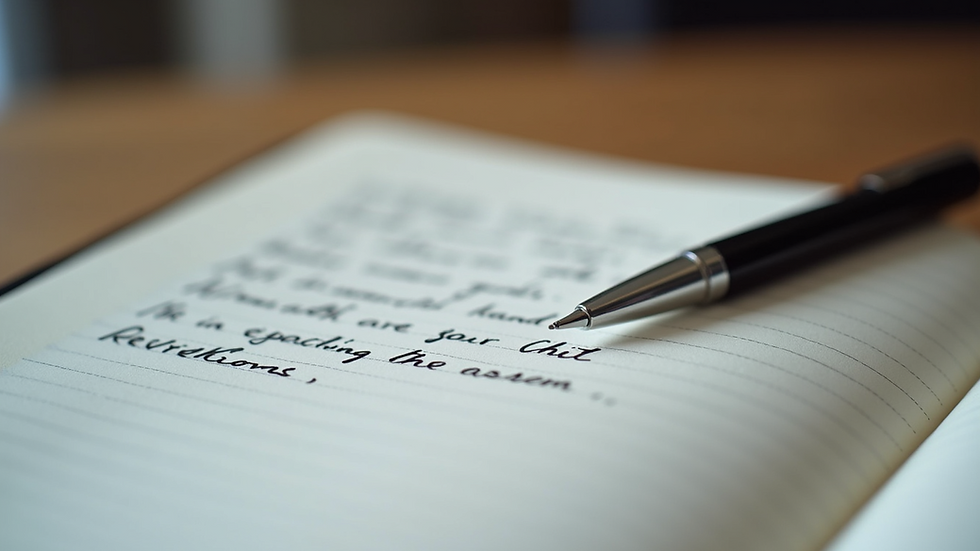Mastering the Art of Effective Personal Statements
- Robert Edinger
- Aug 16
- 5 min read
Writing a personal statement can feel like standing at the edge of a vast ocean, unsure of where to dive in. I remember the first time I faced this task - the pressure to capture my entire academic journey, my ambitions, and my unique qualities in just a few hundred words was overwhelming. Yet, over time, I learned that crafting an effective personal statement is less about perfection and more about authenticity, clarity, and thoughtful reflection. It’s a chance to tell your story in a way that resonates deeply with admissions committees. Today, I want to share insights and practical tips that can help you master this art, making your statement not just a requirement, but a powerful narrative of who you are.
Understanding the Power of Effective Personal Statements
When I first started writing my personal statement, I underestimated its importance. I thought it was just a formality, a box to check. But I soon realized that an effective personal statement is your voice in a sea of applications. It’s your opportunity to stand out by showing not just what you’ve done, but who you are and why you matter.
An effective personal statement does several things well:
Connects your past experiences to your future goals
Demonstrates your passion and commitment
Highlights your unique perspective and strengths
Shows self-awareness and growth
For example, when I applied to graduate school, I shared a story about a challenging research project that taught me resilience and creativity. This wasn’t about listing achievements; it was about showing how those experiences shaped my academic path and fueled my ambitions.

Taking time to reflect and jot down ideas is the first step toward an effective personal statement.
Preparing to Write: Laying the Groundwork for Success
Before you even put pen to paper, preparation is key. The best personal statements come from a place of deep reflection and organization. Here’s how I approached it:
Reflect on your journey
Think about the moments that defined your academic and personal growth. What challenges did you overcome? What achievements are you proud of? What motivates you?
Research the program thoroughly
Understanding the values and focus of the program you’re applying to helps tailor your statement. I made sure to align my goals with what the program offered, showing that I was a perfect fit.
Create an outline
Organizing your thoughts into a clear structure prevents rambling. I usually start with an introduction that hooks the reader, followed by body paragraphs that explore my experiences and goals, and a conclusion that ties everything together.
Gather feedback early
Sharing your draft with mentors or peers can provide valuable perspectives. I learned to embrace constructive criticism as a tool for improvement.
This preparation phase is like setting the foundation of a house - without it, the structure won’t stand strong.
How do you write a killer personal statement?
Writing a killer personal statement is about blending honesty with strategy. Here’s the approach that worked for me and countless others:
Start with a compelling hook
Open with a vivid anecdote or a thought-provoking question. This draws the reader in and sets the tone. For instance, I began my statement with a moment of realization during a volunteer project that sparked my passion for international relations.
Be specific and concrete
Avoid vague statements like “I am passionate about learning.” Instead, describe specific experiences that illustrate your passion. For example, “During my internship at the UN, I witnessed firsthand the complexities of diplomacy, which deepened my commitment to global cooperation.”
Show, don’t just tell
Use examples and stories to demonstrate your qualities. Rather than saying “I am resilient,” narrate a situation where you overcame obstacles.
Maintain a clear and logical flow
Each paragraph should build on the previous one, guiding the reader through your journey smoothly.
Keep your tone authentic and reflective
Admissions committees appreciate honesty and self-awareness. Don’t shy away from discussing challenges or failures if you show how you learned from them.
End with a strong conclusion
Summarize your goals and how the program fits into your future. Leave the reader with a lasting impression of your enthusiasm and readiness.
Remember, writing a killer personal statement is a process. It often takes multiple drafts and revisions to get it right. Patience and persistence pay off.

Revising and refining your draft is essential to crafting a compelling narrative.
Common Pitfalls and How to Avoid Them
Even with the best intentions, it’s easy to stumble into common traps when writing your personal statement. I’ve seen many applicants, including myself at times, fall into these pitfalls:
Being too generic
Statements like “I want to help people” are noble but overused. Dig deeper to explain why and how you want to help, with concrete examples.
Overloading with jargon or clichés
Keep your language clear and straightforward. Avoid buzzwords that don’t add meaning.
Focusing too much on others
While mentors and experiences are important, the statement should center on you - your growth, your insights, your goals.
Ignoring the prompt or guidelines
Always tailor your statement to the specific requirements. Missing word limits or ignoring questions can hurt your chances.
Neglecting proofreading
Typos and grammatical errors distract from your message. I recommend reading your statement aloud and using tools like Grammarly.
By being mindful of these pitfalls, you can ensure your statement remains focused, engaging, and polished.
Bringing It All Together: Your Personal Statement as a Story
At its heart, your personal statement is a story - your story. When I embraced this mindset, the writing process became less daunting and more meaningful. I realized that admissions committees are not just looking for a list of accomplishments; they want to understand the person behind the application.
To bring your story to life:
Use a narrative arc
Introduce a challenge or moment of inspiration, describe your journey, and conclude with your aspirations.
Highlight your unique voice
Don’t be afraid to let your personality shine through. Whether it’s a touch of humor, a reflective tone, or passionate conviction, your voice makes your statement memorable.
Connect your past, present, and future
Show how your experiences have prepared you for the program and how the program fits into your long-term goals.
If you want to explore more examples and tailored advice, I found this resource on personal statements incredibly helpful. It offers insights specifically for international relations applicants, but the principles apply broadly.

Creating a comfortable and inspiring workspace can enhance your writing process.
Embracing the Journey Ahead
Writing your personal statement is more than a task - it’s a journey of self-discovery and expression. Each word you write brings you closer to understanding your own story and how you want to share it with the world. It’s natural to feel vulnerable and uncertain but remember that your unique experiences and perspectives are your greatest strengths.
As you embark on this process, be patient with yourself. Celebrate small victories - a well-crafted sentence, a powerful paragraph, a fresh insight. And don’t hesitate to seek support when needed. Resources like StatementWritingHelp.com exist to guide you through this crucial step, helping you craft statements that truly reflect your potential.
In the end, mastering the art of effective personal statements is about more than admission - it’s about owning your narrative and stepping confidently into your future.






Your piece is a wonderfully engaging exploration of the art of writing personal statements. It immediately draws the reader in with the metaphor of standing at the edge of a vast ocean, which captures both the daunting nature of the task and the sense of possibility it holds. What makes your writing so effective is the way you blend personal reflection with practical guidance. You don’t just tell the reader what to do—you share your own journey, the lessons you learned, and the realizations that transformed your approach. This makes the advice feel authentic and relatable rather than prescriptive.
The narrative flows smoothly, moving from the initial challenge of writing a statement to the deeper understanding of its importance, and…